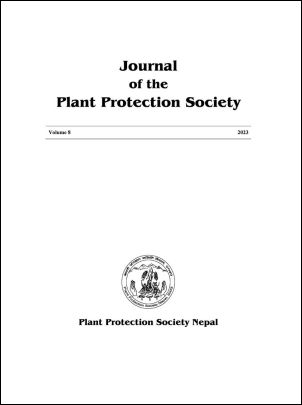Study on Some Species of Trichoderma for the Management of Root Knot Nematode (Meloidogyne spp.) in Tomato
DOI:
https://doi.org/10.3126/jpps.v8i1.56447Keywords:
Gall Index, Meloidogyne spp., root knot nematode, Tomato, Trichoderma spp.Abstract
Pot experiment was conducted to find out the competence of some commercial product of Trichoderma spp. on the management of root knot nematode in tomato crop. The experiment was conducted in RCBD having seven treatments of six different Trichoderma spp. including one control in three replications. Each treatment had five pots. Twenty five days old seedling of Shrijana hybrid tomato was transplanted and inoculated with 1500 eggs of Meloidogyne spp. in soil after five days of transplanting of tomato seedlings. The spore suspensions of different Trichoderma spp. adjusted to 1 × 106 spores/ml and also inoculated per pot with 30 ml after one week of nematode inoculation. The same concentration and amount of Trichoderma spores solution was again inoculated after one month from the date of first application. Sixty five days after transplanting, all tomato plants were uprooted and the number of galls in root, galling index and fresh root weight were determined based on a 0-10 scale. The result showed that the treatments varied significantly in root knot index and number of galls per root system and fresh root weight per plant. The lowest gall index was observed in T. harzianum - Nemastin (1.6), followed by T. harzianum (T22) - Rootshield Plus (2.37) and T. viride (Ashtha TV) (3.43). Similarly, lowest numbers of galls (9.13) was observed in T. harzianum - Nemastin than all other treatments. There was no significant difference in fresh root weight per plant of tomato among the treatments except T. harzianum and T. harzianum (T22). Significantly highest suppressive effect on the nematode population was achieved by T. harzianum- Nemastin (Rf 0.45), followed by T. harzianum, (T22) (Rf 0.61), and T. viride, (Ashtha TV) (Rf 1.43). Different isolates of T. harzianum suppressed root knot disease of tomato as compare the isolates of T. viride. Hence, T. harzianum - Nemastin can be applied as a biological control agent to reduce the nematode population.
Downloads
Downloads
Published
How to Cite
Issue
Section
License

This work is licensed under a Creative Commons Attribution-NonCommercial 4.0 International License.
© Plant Protection Society of Nepal

